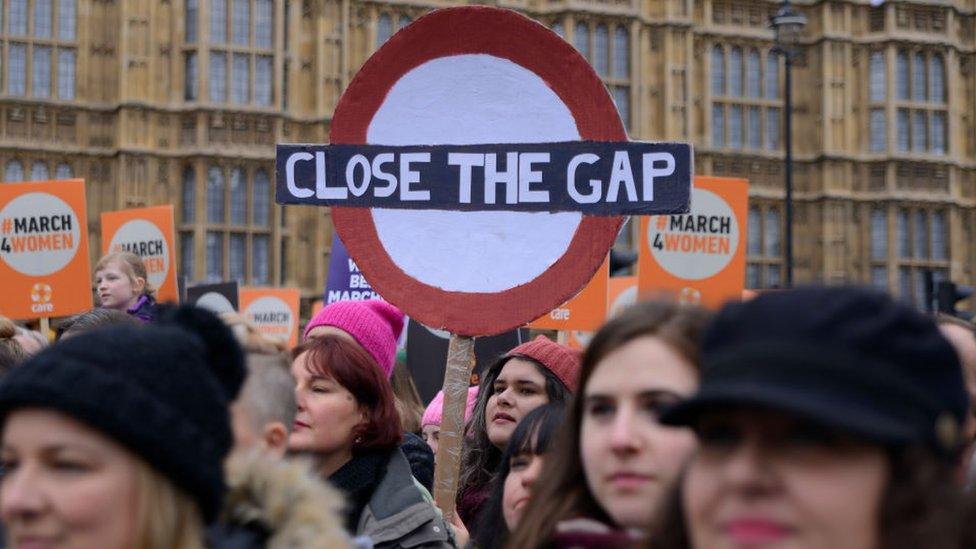Is equal pay actually possible?
- Published

Last year, Iceland became the first country to make companies responsible for paying men and women equally.
Equal pay - paying men and women the same for jobs of equal value - has been a legal requirement in Iceland, the UK and many other countries for decades.
While other countries focus on gender pay, Iceland has put the onus on employers to show they follow the existing laws around equal pay.
The country, which has a population of nearly 350,000 has long been ranked the world's best for overall gender equality., external Could other places benefit from its new workplace strategy?
Equal pay v the gender pay gap
The UK has made it compulsory for large companies to publish the difference in what they pay men and women.
This is called the gender pay gap - the average hourly percentage gap between the salaries received by men and women.
Gender pay gaps can be seen in almost every country in the world.
On average, full-time male employees across the EU and 35 other countries were paid 13.8% more per hour in 2014,, external according to figures from the Organisation for Economic Co-operation and Development (OECD).
At 1.5%, Romania's gap was the smallest, while South Korea's 34.6% gap was the widest.

South Korea had a gender pay gap of 34.6%. according to latest OECD figures
The widespread nature of the gender pay gap suggests workplace equality has not yet been achieved.
How men and women are paid within organisations is one factor contributing to the national pay gap, which in the UK last year was 17.9% for all employees, external.
In 2018, 78% of UK companies paid male employees more on an average (median) basis, according to BBC analysis. These firms are encouraged to come up with an action plan to reduce their gap, but are not legally obliged to.
Want to find out the gender pay gap where you work? Try the calculator below.
Would the Icelandic approach work?
Would the Icelandic approach - proactively enforcing existing equal pay laws - prove more effective?
All large firms must prove they meet an equal pay standard agreed by the government, employers and unions, that prove pay decisions are not influenced by the worker's "social characteristics", notably their gender.
Employers are allowed to pay salaries based on performance, but only if they can demonstrate they are paying equal value for equal work.

Iceland is often ranked best in the world for gender equality
However, focusing on "equal pay for equal work" does not address all the issues contributing to the gender pay gap at individual companies, which often reflects a concentration of men in well-paid senior roles.
What the processes do is direct employers' attention to why they pay people what they do and what each job entails.
Early case studies in Iceland found closer scrutiny of whether pay differences were fair and justifiable increased employees' trust in the pay system and has benefited some men as well as women, external.

What are other countries doing?
France - Large firms must publish five gender pay indicators - including promotions, pay increases and the gender ratio of the 10 best paid employees - generating a score of up to 100. Firms with a score of less than 75 at the end of three years of reporting are liable to a fine of up to 1% of their total payroll
Canada - Ontario is bringing in legislation that will ban companies from asking about applicants' pay history, external and force them to disclose a salary range on external job advertisements. Large firms will also have to track and report their gender pay gap
Switzerland - Firms bidding for public contracts have to show they pay men and women equally, external
Sweden - All but the smallest companies must conduct a yearly pay audit, external to analyse wage policy and whether equal pay practices are being followed. Those with more than 25 employees have to publish an action plan to address any disparity
Why do we still see pay discrepancies?
Although we have equal pay and other anti-discrimination laws, these have not necessarily been fully implemented.
For example, UK supermarkets Asda, Tesco and Morrisons are currently facing high-profile equal pay claims from women who say they are not paid the same as male workers doing different but comparable jobs.
One problem is that it is usually up to an employee - or their union - to challenge companies' pay practices. This could be both expensive and risky for an individual to attempt.

Asda is involved in a long-running legal dispute with staff over equal pay
Secondly, equal pay laws only apply to jobs within an individual company or organisation, which is not particularly helpful in workplaces where most employees are female.
One UK research review, external found pay setting - particularly in the private sector - lacked transparency and tended to focus on market rates, affordability and individual performance.
This means that in practice salaries can vary quite a lot from person to person, and are not always directly linked to the value of work performed.
Fighting the system
Even if equal pay laws were more effectively enforced, wider problems may still persist.
There are several historical and structural factors behind pay inequality. For centuries, men were the breadwinners and women were responsible for domestic and care work, and ONS analysis suggests women still do 10 hours more of this "unpaid work" a week than men do, external.
By contrast, men may be more likely to work longer salaried hours , external.
Equal pay laws also do not help to change the distribution of work. Men are still more likely to work in better-paid firms and sectors, external, while women are more likely to work in sectors or firms where most staff are also female and low paid, particularly if they work part-time.
Shining a light
All of this means workplace equality is unlikely to be achieved by a single measure.
But that does not mean to say these policies won't have any positive effects, or that we shouldn't try to bring about change.
Gender pay gap reporting may do more to shine a light on pay practices.
The public attention it attracts may prompt firms to take action to improve women's pay and career progression to boost their reputation, but that is not guaranteed.
Salary reporting is a good first step, but the UK could make this approach more effective by requiring companies to go beyond simply reporting their gender pay gap by adopting practices likely to reduce it.
While it is early days for Iceland's equal pay strategy, early signs suggest that forcing companies to prove they compensate employees fairly may be more effective than transparency without any consequences.

About this piece
This analysis piece was commissioned by the BBC from experts working for an outside organisation.
Prof Jill Rubery, external is director of the Work and Equalities Institute at Alliance Manchester Business School.

Edited by Eleanor Lawrie
- Published20 February 2019

- Published25 October 2018




